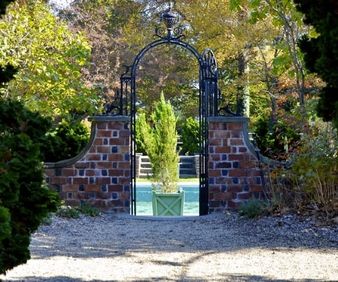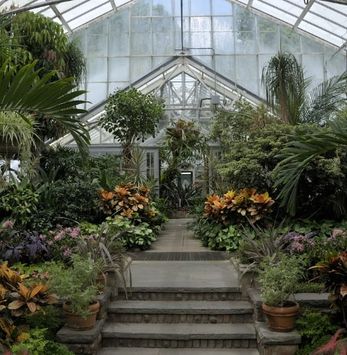
Founded in 1915, Planting Fields Arboretum is a 409-acre oasis located in Oyster Bay, New York, housing dozens of specialty gardens, rolling lawns, woodland paths, and stunning plant collections. The activities in Planting Fields Arboretum are usually dictated by the season, with every season offering something unique to visitors.
With nearly 409 acres of space for exploration, it will certainly take over a day to explore every nook and cranny of Planting Fields Arboretum.
Most plants at Planting Fields Arboretum will peak in the spring and summer growing seasons. Even in the fall and winter months, the gardens at Planting Fields Arboretum will offer you reasons to explore about. The sprawling Planting Fields Arboretum is quite large and may not be seen in a single day
History of Planting Fields Arboretum
The garden has an extensive history and was originally purchased as part of six farming properties by the Byrne Family. They hired James Leal Greenleaf, an architect to create espaliered fruit trees, perennial borders, and hedges. The most notable features of the garden from this era are the Circular Pool, Green Garden Court, and Rose Arbor.
The property was eventually purchased by William Robertson Coe in 1913 who began much of the landscaping under the guidance of Guy Lowell and Robeson Sargent. Two massive beeches from Fairhaven were transported to the property. The trees were transported from Long Island Sound to Planting Fields Arboretum. One of the trees died and was taken down in 2006.
Cherries, Japanese crabapples, rhododendrons, and red pines were brought in bulk from England to enrich greenhouses, woodland, and borders. Some varieties of plants, like the Camellia japonica, were never grown in the United States.
The mansion was burned to the ground in 1918 and was reconstructed between 1918 to 1921. The new construction followed the Tudor Revival Style and was designed by Walker & Gillette.
In 1949, Coe sold the estate to New York State for just $1 in exchange for maintaining the property. Terms of the condition also required the government to keep the estate open to the public for educational purposes. All these years later, the government has honored the terms of the condition.
The land was temporarily used as a campus for a State University New York (SUNY) college of science and engineering during the 50s and 60s. The campus closed its doors in 1968, paving way for the opening of the Planting Fields Arboretum as a state historic park.
It is highly recommended to use a map when visiting the various gardens and natural areas of the garden.
The Gardens
Get some fresh air by walking along one of the many gardens, such as the one through the Synoptic Garden with over 500 types of trees and shrubs that are arranged in alphabetical order by their anime. For a quicker walk, amble along the Camellia Greenhouse, captivating in summer, when the bright Camellia collection blooms. Other notable areas include the Main Greenhouse which was constructed between 1914 to 1921.
The Holly collection features the Conifer Trail, Heather Garden, and Dwarf Conifer Garden. The Holly collection, in particular, has over 100 types of evergreen hollies such as American, Asian, English, and hybrid forms.
Wedell and Costich Gardens
These two woodland gardens are named after horticulturalists and plantsmen Carl Wedell and Edwin Costich. They are located on the southwest section of the estate as you enter the Woodland Trails. They feature berry-producing shrubs that provide sustenance to numerous birds.
Mr. Wedell led the Department of Ornamental Horticulture at SUNY Farmingdale, New York. The estate also serves as a major hotspot for birders because of the wide variety of birds that visit the area. Commonly sighted birds include the tree swallow, northern cardinal, red-winged blackbird, mourning dove, the American robin, and Baltimore oriole.
A Peek Inside Coe Hall

Planting Fields Arboretum has several buildings, but the biggest of these is Coe Hall with 65 rooms spanning over 26,000 square feet. The family dining room contains interesting artwork belonging to Robert Winthrop Chanler depicting scenes from the American West.
This is mostly because Coe was interested in the conflict between America and the West, and often collected documents related to settlers of the time. The Coe Hall also includes the bedrooms where the Coes, their guests, and staff. This tour includes the West Guest Suite, Mai Coe’s suite, East Guest suite, Governess’s room, Valet’s room, and W.R. Coe’s suite.
Mai Coe’s suite allows you to closely examine Mai’s role in developing the planting fields. This tour will let you get a sense of Mai’s aesthetic interests and personality. The tour of Mai Coe’s suite includes the Buffalo room, the French Reception room, the Blue Pool garden, the Tea House, Vista Allee, and the Cloister Garden.
The interior of the house is a demonstration of excellent craftsmanship that features a unique aesthetic through the works of various artists such as Everett Shinn and Robert Winthrop Chanler. The park has been included in the National Register of Historic Places, the official list of the Nation’s historic sites.
Trails and Nature Areas
Planting Fields has about five miles of woodland trails that take visitors into 200 acres of native forest. The unique topology of the woodlands in the estate is not commonly found on Long Island.
This explains why the terrain supports the diverse habitats for plants and wildlife. The primary plant of the area is Eastern White Pine. Other shrubs include beech, dogwood, hickory, rhododendron, mountain laurel, and others.
Herbaceous plants include violets, trilliums, lady slipper orchids, and ferns. Visitors have reported sightings of wildlife unique to the woodlands such as squirrels, chipmunks, rabbits, and raccoons. A large number of migratory birds are also present throughout the year, these include robin Baltimore oriole, cardinal, indigo bunting, sparrow, starling, and the red-tailed hawk.
Wrapping Up
So there you have it, an in-depth look at Planting Fields Arboretum. The park was designed to provide a unique educational experience for the public. Visitors also can engage with the estate on the official website which contains learning kits, videos, and news about activities being launched.
